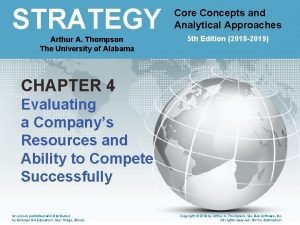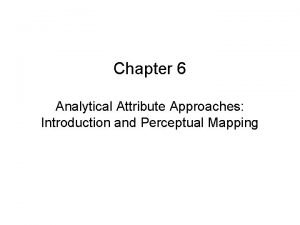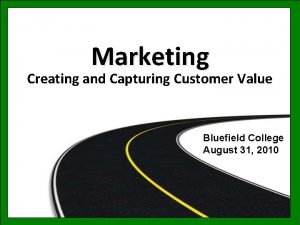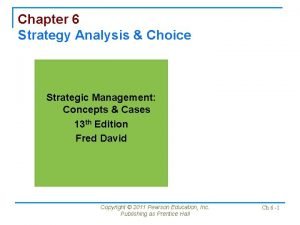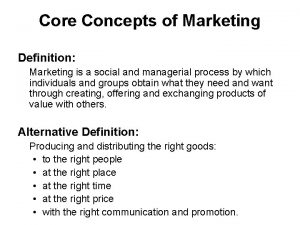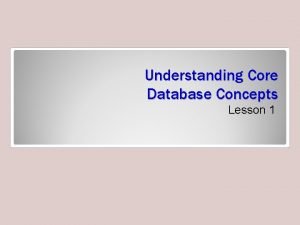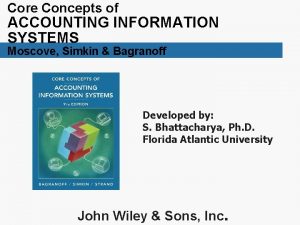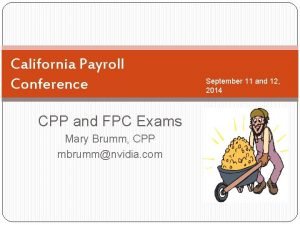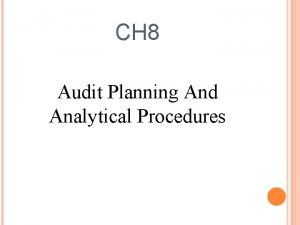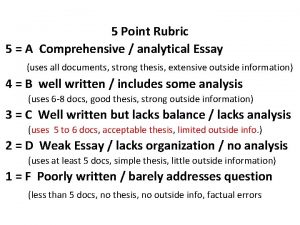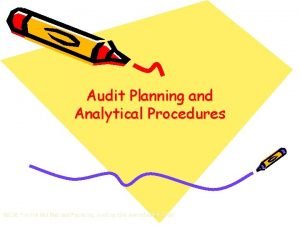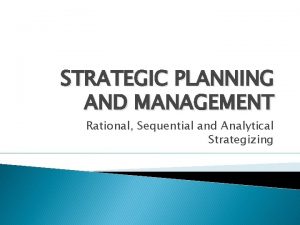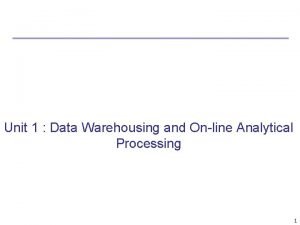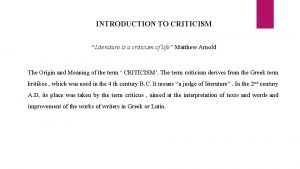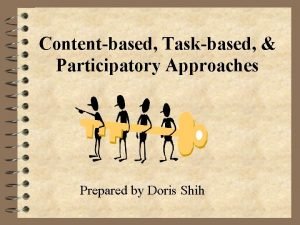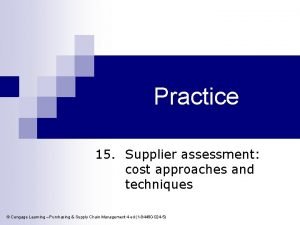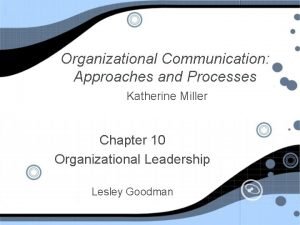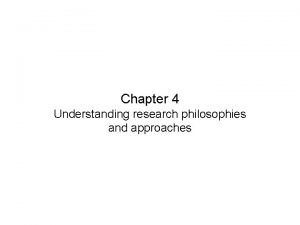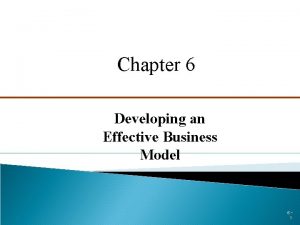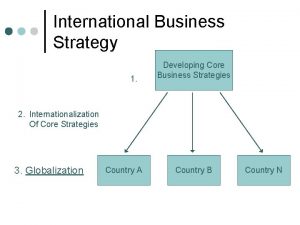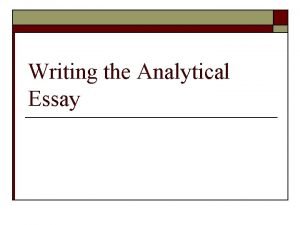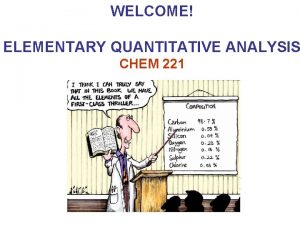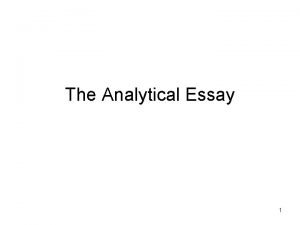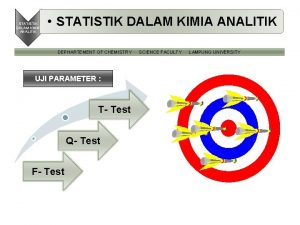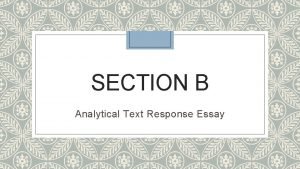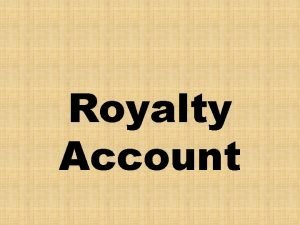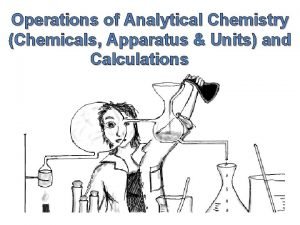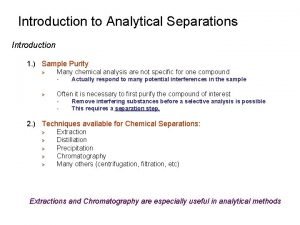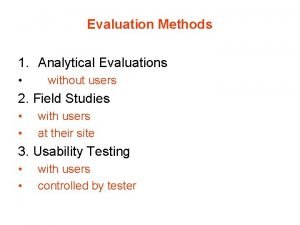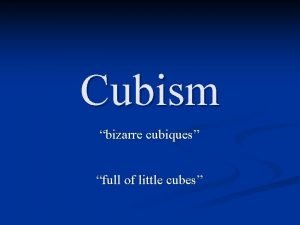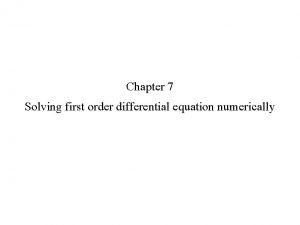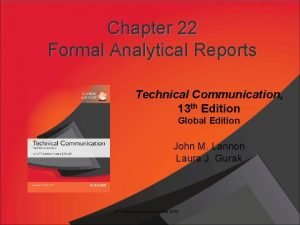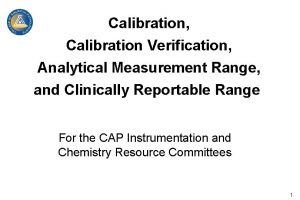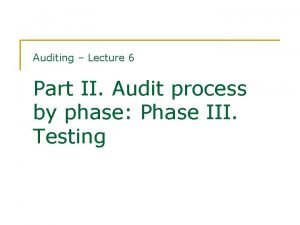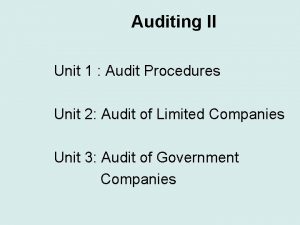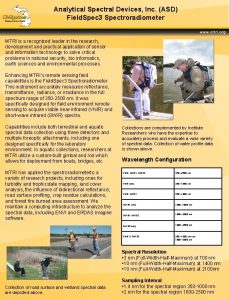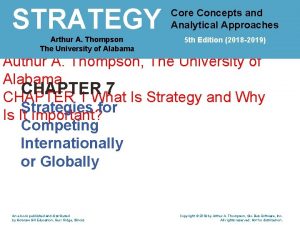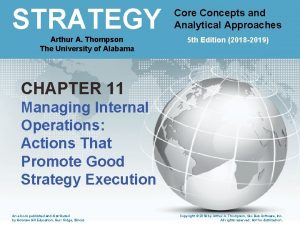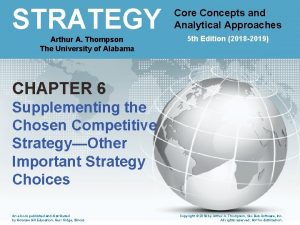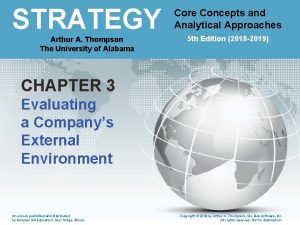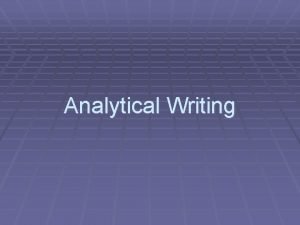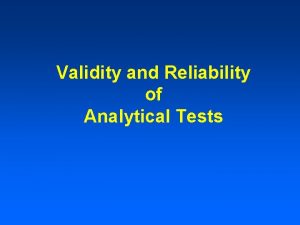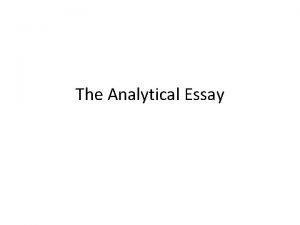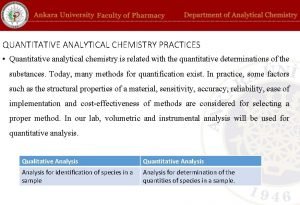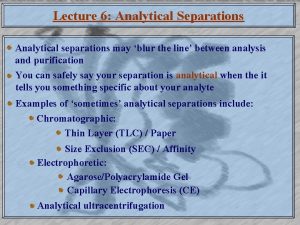STRATEGY Core Concepts and Analytical Approaches Strategy Core












































































































- Slides: 108

STRATEGY Core Concepts and Analytical Approaches Strategy – Core Concepts and Analytic 5 th Edition (2018 -2019) Approaches 5 e Authur A. Thompson, The University of Alabama CHAPTER 4 CHAPTER 1 What Is Strategy and Why Evaluating Is It Important? a Company’s Arthur A. Thompson The University of Alabama Resources and Ability to Compete Successfully An e-book published and distributed by Mc. Graw Hill Education, Burr Ridge, Illinois Copyright © 2018 by Arthur A. Thompson, Glo-Bus Software, Inc. All rights reserved. Not for distribution.

Before executives can chart a new strategy, they must reach a common understanding of the company’s current position. W. Chan Kim and Rene Mauborgne Copyright © 2018 by Glo-Bus Software, Inc. 4– 2

Organizations succeed in a competitive marketplace over the long run because they can do certain things their customers value better than can their competitors. Robert Hayes, Gary Pisano, and David Upton Copyright © 2018 by Glo-Bus Software, Inc. 4– 3

A new strategy nearly always involves acquiring new resources and capabilities. Laurence Capron and Will Mitchell Copyright © 2018 by Glo-Bus Software, Inc. 4– 4

Learning Objectives 1. Learn how to determine whether a firm’s strategy is working well and to evaluate the competitive power of a firm’s resources and capabilities. 2. Understand the meaning and significance of company and industry value chains. 3. Gain proficiency in using four analytical tools to evaluate a firm’s ability to compete successfully: SWOT analysis, value chain analysis, benchmarking, and competitive strength assessment. 4. Learn what to look for in identifying the strategic issues company managers must address. Copyright © 2018 by Glo-Bus Software, Inc. 4– 5

Chapter 4 Roadmap § Evaluating a Firm’s Resources and Ability to Compete Successfully: The Six Questions to Answer ► Question 1: How Well Is the Firm’s Present Strategy Working? ► Question 2: What Are the Firm’s Important Resources and Capabilities and Do They Have the Competitive Power to Enable the Company to Build and/or Sustain a Competitive Advantage over Rivals? ► Question 3: Are the Firm’s Resources and Capabilities Attractive and Well. Matched to Its Market Opportunities and External Threats? ► Question 4: Are the Firm’s Prices and Costs Competitive with Those of Key Rivals and Does It Have an Attractive Customer Value Proposition? ► Question 5: Is the Firm Competitively Stronger or Weaker than Key Rivals? ► Question 6: What Strategic Issues and Problems Merit Front-burner Managerial Attention? Copyright © 2018 by Glo-Bus Software, Inc. 4– 6

Evaluating a Firm’s Ability to Compete Successfully: Six Key Questions § The analytical spotlight in evaluating a firm’s resources and ability to compete successfully is trained on six questions: ► ► ► How well is the company’s present strategy working? What are the company’s important resources and capabilities, and do they have the competitive power to enable the company to build and/or sustain a competitive advantage over rival companies? Does the company have attractively strong resource capabilities and how well do they match its market opportunities and the external threats to its future well-being? ► Are the company’s prices and costs competitive with those of key rivals, and does it have an appealing customer value proposition? ► Is the company competitively stronger or weaker than key rivals? ► What strategic issues and problems merit front-burner managerial attention? Copyright © 2018 by Glo-Bus Software, Inc. 4– 7

Question 1: How Well Is the Firm’s Present Strategy Working? § Begin by understanding what its strategy is: ► Identify the firm’s competitive approach • Lower-costs relative to rivals? • A different or better product/service? • Superior ability to serve a particular market niche or group of buyers? ► Determine its competitive scope • Broad or narrow geographic market coverage? • Wide or narrow product line? ► Examine recent strategic moves ► Identify functional strategies Copyright © 2018 by Glo-Bus Software, Inc. 4– 8

FIGURE 4. 1 Identifying the Components of a Single-Business Company’s Strategy Copyright © 2018 by Glo-Bus Software, Inc. 4– 9

Key Indicators of How Well a Company’s Strategy Is Working § The three best indicators: ► Whether the firm is meeting or beating its financial and strategic performance targets ► Whether the firm is an above-average industry performer ► Whether the firm is gaining customers and outcompeting one or more of its close rivals Persistent shortfalls in meeting performance targets and weak performance relative to rivals are warning signs that the firm has a weak strategy or suffers from poor strategy execution or both. Copyright © 2018 by Glo-Bus Software, Inc. 4– 10

Other Good Indicators of How Well a Company’s Strategy Is Working § Whether the firm’s sales are growing faster, slower, or at about the same pace as the market as a whole, thus resulting in a rising, eroding, or stable market share. § How well the firm stacks up against rivals on product innovation, customer service, product quality, delivery time, price, getting newly developed products to market quickly, and other relevant factors affecting buyers’ choice of brands. § Whether the firm’s image and reputation with its customers is growing stronger or weaker. § § Whether the firm’s profit margins are increasing or decreasing. § Whether the firm’s overall financial strength, credit rating, key financial and operating ratios, and cash flows from operations are improving, holding steady, or deteriorating. Trends in the firm’s net profits and return on investment and how these compare to the same trends for rival companies. Copyright © 2018 by Glo-Bus Software, Inc. 4– 11

Strategic Insight Sluggish financial performance and second-rate market accomplishments almost always signal weak strategy, weak execution, or both. Copyright © 2018 by Glo-Bus Software, Inc. 4– 12

Evaluating a Company’s Financial Performance § Accurate diagnosis of a company’s financial performance and financial statements requires some number-crunching. § The financial ratios in Table 4. 1 provide guidance and direction in what numbers need to be calculated and how to interpret them. Copyright © 2018 by Glo-Bus Software, Inc. 4– 13

TABLE 4. 1 Key Financial Ratios: How to Calculate Them and What They Mean Copyright © 2018 by Glo-Bus Software, Inc. 4– 14

TABLE 4. 1 Key Financial Ratios: How to Calculate Them and What They Mean Copyright © 2018 by Glo-Bus Software, Inc. 4– 15

TABLE 4. 1 Key Financial Ratios: How to Calculate Them and What They Mean Copyright © 2018 by Glo-Bus Software, Inc. 4– 16

TABLE 4. 1 Key Financial Ratios: How to Calculate Them and What They Mean Copyright © 2018 by Glo-Bus Software, Inc. 4– 17

Question 2: What Are the Company’s Resources and Capabilities and Do They Have the Competitive Power to Enable the Company to Build and/or Sustain a Competitive Advantage Over Rivals? § § A company’s resources and capabilities are competitive assets and determine whether its competitive power in the marketplace will be impressively strong or disappointingly weak. ► Companies with second-rate competitive assets nearly always are relegated to a trailing position in the industry Resource and capability analysis is a two-step process for determining whether a company’s competitive assets can provide the foundation necessary for competitive success in the marketplace. ► The first step is to identify the company’s competitively important resources and capabilities. ► The second step is evaluate the competitive power of these resources and capabilities—whether they are potent enough for the company to be competitively successful and perhaps achieve a sustainable competitive advantage over rival firms Copyright © 2018 by Glo-Bus Software, Inc. 4– 18

Identifying a Company’s Valuable Resources § Any asset or productive input that a firm owns or controls qualifies as a resource. ► Firms typically have many kinds and types of resources ► More importantly, a company’s resources tend to vary widely in quality, competitive relevance, and competitive value § Our interest here is not in cataloging every resource a company has but rather in identifying those resources that are competitively relevant, assessing their competitive value, and evaluating the degree to which they can underpin its strategy. Copyright © 2018 by Glo-Bus Software, Inc. 4– 19

Types of Competitively Relevant and Valuable Company Resources § Competitively relevant and potentially valuable resources can relate to: ► Physical assets—natural-resource deposits, real estate, store locations, plants, equipment, and distribution facilities ► Human assets and intellectual capital—the education, training and experience of company’s workforce, special expertise and skills, managerial skills, the work ethic and motivational drive of the company’s workforce ► Organizational resources—quality control systems, proprietary technology, state-of-the-art information systems, patents, just-in-time inventory systems ► Financial resources—cash on hand, balance sheet strength, credit rating, and strength of access to additional financial capital ► Intangible assets—brand names, buyer loyalty and goodwill, trademarks, company image and reputation ► Relationships—alliances or partnerships with suppliers, distributors, dealers, and others that reduce costs and/or provide access to valuable technologies, specialized know-how, or attractive geographic markets Copyright © 2018 by Glo-Bus Software, Inc. 2– 20

Identifying Valuable Company Capabilities § § A capability concerns the proficiency with which a company can perform an activity. In general, the competitive value of a company’s capability to perform an activity depends on two factors: ► ► The proficiency a company has achieved in performing the activity The role of the activity in the company’s strategy and its importance to the company’s competitive success and performance § There are four competitively relevant levels of capability: ► ► Minimal capability—achieved when a company has performed an activity one or more times but still lacks the proficiency needed to perform the activity consistently well and at acceptable cost A demonstrated competence in performing an activity A core competence—a demonstrated competence in performing a competitively relevant activity that is central to the company’s strategy A distinctive competence—the capability to perform a competitively valuable activity better than any other company in the industry Copyright © 2018 Glo-Bus Software, Inc. 2– 21

A Company Competence § A company’s proficiency in performing an activity rises from that of minimal capability to the level of a proven competence when it demonstrates enough proficiency to perform the activity consistently well and at acceptable cost ► Usually, competence in performing an activity originates with deliberate efforts to simply develop the ability to do it, however imperfectly or inefficiently. Then, as experience builds and the company gains enough proficiency to perform the activity consistently well and at an acceptable cost, its ability evolves into a true competence and capability. § Whether a competence has competitive value depends on whether it relates directly to a company’s strategy and competitive success or whether it has minimal competitive bearing (like routine maintenance or administering employee benefit programs). Copyright © 2018 Glo-Bus Software, Inc. 2– 22

Core Concept A firm has a competence in performing an activity competence when, over time, it gains the experience, knowhow, and proficiency to perform that activity consistently well and at acceptable cost. consistently cost Copyright © 2018 by Glo-Bus Software, Inc. 4– 23

Examples of Company Competencies § § § Specific skills and expertise (like proficiencies in low-cost manufacturing, picking locations for new stores, or designing an unusually appealing and functional social media website) Proficiency in a single discipline or function that is performed in a single department or organizational unit Inherently multidisciplinary and cross-functional activities that are the result of effective collaboration among people with different expertise working in different organizational units ► A competence in continuous product innovation, for example, comes from teaming the efforts of people and groups with expertise in market research, new product R&D, design and engineering, cost-effective manufacturing, and market testing Virtually all organizational capabilities and proven competencies are knowledge based, residing in people and in a company’s intellectual capital Copyright © 2018 Glo-Bus Software, Inc. 2– 24

A Core Competence—A Competitvely Valuable Capability § A proven competence takes on a higher level of competitive competence § value and becomes a core competence when a company achieves a high level of proficiency in performing an activity that is central to its strategy and competitiveness. A core competence is a more competitively valuable capability than a competence because ► It adds power to a company’s strategy ► This added power, in turn, positively impacts • The company’s efforts to compete successfully against rivals • The company’s ability to achieve its financial and strategic objectives • The company’s overall performance Copyright © 2018 Glo-Bus Software, Inc. 2– 25

Core Concept A core competence is an activity that a firm performs not only consistently well and at acceptable cost, but that is also central to its strategy and competitiveness. A core competence is a more competitively valuable capability than a competence because it adds power to a firm’s strategy and has a bigger positive impact on its competitive strength and profitability. Copyright © 2018 by Glo-Bus Software, Inc. 4– 26

Examples of Core Competencies § A core competence can relate to any of several aspects of a company’s business and strategy: ► ► ► Expertise in product innovation Expertise in developing new and more efficient production technologies Expertise in marketing Skills in manufacturing a high-quality product at a low cost Strong capability to fill customer orders accurately and swiftly § Often, the most valuable core competencies are grounded in cross-department combinations of knowledge and expertise rather than being the product of a single department or work group Copyright © 2018 Glo-Bus Software, Inc. 2– 27

A Distinctive Competence—A Very Competitively Valuable Capability § A core competence rises to an even higher level of § § competitive importance and becomes a distinctive competence when a company is able to achieve sufficiently high proficiency to perform a competitively important activity better than its rivals A distinctive competence thus represents a greater proficiency (and a stronger capability) than a core competence Because a distinctive competence represents a level of proficiency that rivals do not have, it qualifies as a competitively superior capability with competitive advantage potential Copyright © 2018 Glo-Bus Software, Inc. 2– 28

Core Concept A distinctive competence is a competitively important activity that a company performs better than its rivals—it thus represents a competitively superior capability Because a distinctive competence represents a competitively valuable capability that rivals do not have, it can be a basis for sustainable competitive advantage. Copyright © 2018 by Glo-Bus Software, Inc. 4– 29

Why a Distinctive Competence Matters § A distinctive competence adds real power to a firm’s strategy and provides a pathway to competitive advantage when: ► It relates to an activity important to competitive success ► Rival companies do not have offsetting competencies or capabilities ► It is costly and time-consuming for rivals to imitate the competence Copyright © 2018 by Glo-Bus Software, Inc. 4– 30

Core Concept A company’s resources and capabilities represent its competitive assets and are big determinants of its competitiveness and ability to succeed in the marketplace. Copyright © 2018 by Glo-Bus Software, Inc. 4– 31

Astute Bundling of a Company’s Resources and Capabilities Can Result in Added Competitive Power § A particular resource or capability which may not seem to have much competitive value by itself can be much more valuable when bundled with certain other company resources and/or capabilities (that also, taken singly, appear to lack “high” competitive value). ► For example, Nike’s resource bundle of styling expertise, professional endorsements, well-regarded brand name and image, marketing and brand-building skills, network of distributors/retailers, and managerial know-how has provided sufficient competitive power for Nike to remain the dominant global leader in athletic footwear and sports apparel for over 20 years Copyright © 2018 by Glo-Bus Software, Inc. 2– 32

Core Concept A resource/capability bundle is a group of resources and capabilities that, when linked and integrated into a functioning whole, has greater competitive value than the summed value of the individual resource/capability components—in other words, combining individual resources and capabilities into an integrated bundle produces a 1 +1 = 3 gain in competitive power versus just a 1 + 1 = 2 gain when the same resources and capabilities are unbundled. Copyright © 2018 by Glo-Bus Software, Inc. 4– 33

Ways to Test the Competitive Power of a Resource or Capability § The competitive power of a resource or capability is measured by how many of the following four tests it can pass: 1. Does the resource or capability have competitive value? 2. Do many or most rivals have much the same resource or capability? 3. Is the resource or capability hard to copy? 4. Can the value of a resource or capability be trumped by substitute resources and capabilities of rivals? Copyright © 2018 by Glo-Bus Software, Inc. 4– 34

Core Concept The degree of success a company enjoys in the marketplace is governed by the combined competitive power of its resources and capabilities. Copyright © 2018 by Glo-Bus Software, Inc. 4– 35

Does a Company Have a Competitively Attractive Collection of Resources and Capabilities? § Some things to consider in evaluating the attractiveness of a company’s set of resources, competencies, and capabilities ► Both core competencies and distinctive competencies are valuable because they enhance a company’s competitiveness ► However, some competencies merely enable market survival because most rivals also possess them ► Not having an important competence or competitive capability that rivals have can result in competitive disadvantage Copyright © 2018 by Glo-Bus Software, Inc. 4– 36

A Company’s Important Resources and Capabilities Must Be Dynamic and Freshly. Honed to Sustain Its Competitiveness § Why is it important for a company to keep competencies updated and on the cutting-edge? § It often takes freshly-honed and sometimes totally refurbished or altogether new resources/capabilities ► To effectively respond to ongoing changes in customer needs and expectations ► To protect accompany’s long-term competitiveness against the improving resources/capabilities and strategic maneuvering of rivals to steal away customers ► To help maintain or improve its performance over the long-term Copyright © 2018 by Glo-Bus Software, Inc. 4– 37

Core Concept A company requires a dynamically evolving portfolio of competitively valuable resources and capabilities to sustain its competitiveness and help drive improvements in its performance. Otherwise, the power of its competitive assets grow stale. Copyright © 2018 by Glo-Bus Software, Inc. 4– 38

Dynamic Capabilities—What to Do? Management’s challenge in developing dynamic capabilities has two elements: 1. Attending to ongoing recalibration of existing competencies and capabilities 2. Casting a watchful eye for opportunities to develop totally new capabilities for delivering better customer value and/or outcompeting rivals Keeping company competencies freshly honed and on the cutting edge is a strategically important top management task. Copyright © 2018 by Glo-Bus Software, Inc. 4– 39

Strategic Insight Executive attention to making sure a company always has competitively valuable resources and capabilities that dynamically evolve and help sustain the company’s competitiveness is a strategically important top management task. Copyright © 2018 by Glo-Bus Software, Inc. 4– 40

Question 3: What Are the Company’s Strengths and Weaknesses and How Do They Relate to Its Market Opportunities and External Threats? § SWOT analysis ► Zeros in on a firm’s competitively important Strengths and Weaknesses, its market Opportunities, and those external Threats that can adversely impact the firm’s well -being. ► Has considerable managerial value because it helps managers single out and focus on all the factors needed to craft a winning strategy that fits the firm’s overall internal and external situation. Copyright © 2018 by Glo-Bus Software, Inc. 4– 41

Core Concept SWOT analysis is a simple but powerful tool for sizing up a company’s competitively relevant strengths and weaknesses, its market opportunities, and the external threats to its future well-being. Copyright © 2018 by Glo-Bus Software, Inc. 4– 42

FIGURE 4. 2 The Three Steps of SWOT Analysis: Identify, Draw Conclusions, Translate into Strategic Action Copyright © 2018 by Glo-Bus Software, Inc. 4– 43

Identifying a Company’s Competitively Relevant Strengths § Tying strategy to the company’s most competitively potent resources and capabilities is a no-risk proposition. There’s nothing to lose and much to gain. ► If the firm’s resource strengths and capabilities turn out to be competitively stronger than those of some or many rivals, its business performance is certain to improve ► And, in the best-case outcome, effectively deploying competitively valuable resources and capabilities that are hard for rivals to copy or trump usually puts achieving a sustainable competitive advantage within reach Copyright © 2018 by Glo-Bus Software, Inc. 4– 44

Identifying a Company’s Competitively Relevant Strengths § A competitively relevant strength can be ► ► ► Something a company is good at doing (a competitively important capability or a core competence) A competitively valuable resource (like a well-known brand name or state-of-the-art plants and/or distribution centers, proprietary technology, valuable natural resources, or large numbers of hightraffic store locations) Certain kinds of competitively relevant achievements or attributes that contribute to a company’s competitiveness in the marketplace (like having low overall costs relative to competitors, being a market share leader, having a wider product line than rivals, and having wider geographic market coverage than rivals). Copyright © 2018 Glo-Bus Software, Inc. 2– 45

Core Concept A company’s competitively relevant strengths are competitive assets that positively impact its competitiveness and ability to succeed in the marketplace. Copyright © 2018 by Glo-Bus Software, Inc. 4– 46

TABLE 4. 2 What to Look for in Identifying a Firm’s Strengths • • • • • Core competencies in _______ A distinctive competence in _______ A product that is strongly differentiated from those of rivals Resources and capabilities well matched to industry key success factors A strong financial condition; ample financial resources to grow the business Strong brand name/company reputation Strong customer loyalty Proven technological capabilities, proprietary technology/important patents Strong bargaining power over suppliers or buyers Cost advantages over rivals Skills in advertising and promotion Product innovation capabilities Proven capabilities in improving production processes Good supply chain management capabilities Strong customer service capabilities Better product quality relative to rivals Wide geographic coverage and/or strong global distribution capability Alliances/joint ventures with firms that provide access to valuable technology, expertise and/or attractive geographic markets Copyright © 2018 by Glo-Bus Software, Inc. 4– 47

A Company’s Strategy Should Rely Upon Its Most Competitively Powerful Resources and Capabilities § A company’s strategy should be anchored on and seek to fully exploit its most competitively powerful resources and capabilities (and also competitively valuable bundles of resources/capabilities) WHY? Because using its most potent resources and capabilities to power strategic initiatives to deliver value to customers and win business away from rivals gives a company its best chances for competitive success and better performance. Copyright © 2018 by Glo-Bus Software, Inc. 4– 48

Identifying a Company’s Important Weaknesses and Competitive Deficiencies § A weakness, or competitive deficiency, is weakness something a firm lacks, does poorly, or that puts it at a disadvantage in the marketplace § Resource weaknesses relate to: ► Inferior or unproven skills, capabilities, expertise, or intellectual capital in important areas of the business ► Deficiencies in competitively important physical, organizational, or intangible assets ► Missing or competitively weak capabilities in key areas Copyright © 2018 by Glo-Bus Software, Inc. 4– 49

Core Concept A firm’s competitively relevant weaknesses are internal shortcomings or resource/capability deficiencies that constitute competitive liabilities. The degree to which a firm’s weaknesses make it competitively vulnerable depends on how much they matter in the marketplace and the extent to which they can be offset by the firm’s competitively valuable resources and capabilities Copyright © 2018 by Glo-Bus Software, Inc. 4– 50

TABLE 4. 2 What to Look for in Identifying a Firm’s Weaknesses • No well-developed or proven core competencies • Resources and capabilities that are not well matched to an industry’s key success factors • Too much debt; a weak credit rating • Short on financial resources to grow the business and pursue promising initiatives • Higher overall unit costs relative to key rivals • Weaker product innovation capabilities than key rivals • A product/service with attributes or features inferior to those of rivals • Too narrow a product line relative to rivals • Weaker brand name/reputation than rivals • Weaker dealer network than key rivals • Weak global distribution capability • Weaker product quality, R&D, and/or technological know-how than key rivals • In an overcrowded strategic group • Losing market share because _____ • Competitive disadvantages in ____ • Inferior intellectual capital relative to rivals • Subpar profitability because _____ • Plagued with internal operating problems or obsolete facilities • Too much underutilized plant capacity Copyright © 2018 by Glo-Bus Software, Inc. 4– 51

Identifying a Firm’s Market Opportunities § To tailor the firm’s strategy to its situation, managers must first identify and appraise its market opportunities and the growth and profit potential each one holds. § A firm’s market opportunities can be: ► Plentiful or scarce, fleeting or lasting ► Very attractive (an absolute “must” to pursue) ► Marginally interesting (because of the high risks or large capital requirements or unappealing revenue growth and profit potentials) ► Unsuitable (because its resource strengths and capabilities are illsuited to capturing particular opportunities) Copyright © 2018 by Glo-Bus Software, Inc. 4– 52

Identifying a Firm’s Market Opportunities § The market opportunities most relevant to a firm are those that: ► Match up well with the firm’s competitively valuable resources and capabilities ► Offer the best prospects for growth and profitability ► Present the most potential for achieving competitive advantage Sound Advice A firm should pass on a particular market opportunity unless it has or can acquire the resources and capabilities to capture it. Copyright © 2018 by Glo-Bus Software, Inc. 4– 53

TABLE 4. 2 What to Look for in Identifying Market Opportunities • Openings to win market share from rivals • Sharply rising buyer demand for the industry’s product • Serving additional customer groups or market segments • Expanding into new geographic markets • Expanding the company’s product line to meet a broader range of customer needs • Utilizing existing company skills or technological knowhow to enter new product lines or new businesses • Online sales via the Internet • Integrating forward or backward • Falling trade barriers in attractive foreign markets • Acquiring rival firms or companies with attractive capabilities • Entering into alliances or joint ventures to expand the firm’s market coverage or boost its competitiveness • Openings to exploit emerging new technologies Copyright © 2018 by Glo-Bus Software, Inc. 4– 54

Identifying External Threats to a Firm’s Future Profitability § Factors in a firm’s external environment can pose threats to its profitability and competitive well-being § External threats vary in importance ► Some pose only a moderate degree of adversity (most all companies confront some threatening outside elements in the course of conducting their business) ► Some may be formidable enough to make a firm’s situation and outlook quite tenuous ► On rare occasions, a market shock can give birth to a sudden-death threat throws a firm into an immediate crisis and battle to survive Copyright © 2018 by Glo-Bus Software, Inc. 4– 55

TABLE 4. 2 What to Look for in Identifying External Threats • More intense competitive pressures from industry rivals and/or sellers of substitute products—may squeeze profit margins • The entry (or likely entry) of new competitors into the company’s market stronghold (especially lower-cost foreign competitors) • Growing bargaining power of buyers or suppliers • Slowing or declining market demand for the industry’s product • A shift in buyer needs and tastes away from the industry’s product • Adverse demographic changes that threaten to curtail demand for the industry’s product • Vulnerability to unfavorable industry driving forces • Unfavorable trade policies and tariffs; a threat of trade wars • Costly new regulatory requirements • Tight credit conditions • Rising prices for energy or other key inputs Copyright © 2018 by Glo-Bus Software, Inc. 4– 56

What Do the Four SWOT Lists Reveal? § The two most important parts of SWOT analysis are ► Drawing conclusions from the SWOT listings about the company’s overall situation, and ► Translating these conclusions into strategic actions and an overall strategy that is well-matched to the company’s overall situation—as indicated by its strengths and weaknesses, its market opportunities, and its external threats. Copyright © 2018 Glo-Bus Software, Inc. 2– 57

What Story Do the SWOT Listings Tell? The answers to the following questions often reveal the story in the 4 lists: § What are the attractive aspects of the firm’s situation? § What aspects are of the most concern? § Does the firm have sufficient resource strengths/competitive capabilities to compete successfully? § Are the company’s weaknesses/deficiencies of major or minor consequence? Must remedial action be taken immediately? Or, are the weaknesses/deficiencies sufficiently offset by the company’s strengths and competitive assets that corrective action is probably not the best use of company resources? § Does the company have resources and capabilities that are especially well-suited to successfully pursuing and capturing its most attractive market opportunities? § Is the firm lacking certain resources and/or capabilities that make it inadvisable to pursue any of the market opportunities (especially those that are most attractive)? § Are the external threats alarming, or are they something the firm appears able to withstand and/or deal with and/or defend against? § Considering the four lists, where on a scale of 1 to 10 (where 1 is alarmingly weak and 10 is exceptionally strong) should the firm’s position and overall situation be ranked? Copyright © 2018 by Glo-Bus Software, Inc. 4– 58

Translating the SWOT Analysis Results into Effective Strategic Action § Managers can use SWOT results to craft a winning strategy (or to improve an existing strategy) that can pass the three tests of a winning strategy that: ► Best fits the company’s internal and external situation ► Helps build and strengthen its competitive advantage ► Boosts its strategic and financial performance The payoff from SWOT analysis comes from the conclusions about a company’s situation and the implications for strategy improvement that flow from the four lists Copyright © 2018 by Glo-Bus Software, Inc. 4– 59

Core Concept Relying on a company’s strongest resources and capabilities to power its strategy produces the best fit with the company’s internal and external situation, thereby making such an approach to crafting strategy the surest route to market success and good business results. Copyright © 2018 by Glo-Bus Software, Inc. 4– 60

Translating the SWOT Analysis Results into Effective Strategic Action (continued) § Four conditions necessary for a firm’s strategy to be a good to excellent fit with its overall situation: ► ► The foundation and centerpiece of a company’s strategy to profitably compete against rivals must be its most competitively powerful resources and capabilities. The strategy must include actions to correct those weaknesses that make it vulnerable to attack from rivals, depress profitability, or disqualify it from pursuing a particularly attractive opportunity. The strategy must include strategic initiatives to capture those market opportunities best suited to its strengths and competitive assets. The company’s most potent resources and capabilities should usually spearhead such initiatives. The strategy should include efforts to defend against external threats that can adversely impact the company’s long-term business prospects or put its survival at risk. Copyright © 2018 by Glo-Bus Software, Inc. 4– 61

Question 4: Are the Firm’s Prices and Costs Competitive with Those of Key Rivals , and Does It Have an Appealing Customer Value Proposition? § Two telling signs of whether a firm’s business position is strong or precarious: ► Whether its prices are justified by the value it delivers to customers ► Whether its costs are competitive with industry rivals delivering similar customer value at a similar price § Two analytical tools useful in determining whether its customer value proposition, prices, and costs are competitive: ► Value chain analysis ► Benchmarking Copyright © 2018 by Glo-Bus Software, Inc. 4– 62

The Concept of a Company Value Chain § A firm’s value chain ► Concerns the functions, tasks, and activities that a firm performs internally to create value for customers ► Consists of two broad categories of activities • Primary activities that are foremost in the firm’s scheme for creating and delivering value to customers • Support activities that facilitate and enhance the performance of primary activities. § A firm has no sound business justification for performing an activity that does not result in greater value for customers Copyright © 2018 by Glo-Bus Software, Inc. 4– 63

Core Concept A company’s value chain identifies the primary activities it performs that create customer value and the related support activities. The “outputs” of an organization’s value chain activities are the value delivered to customers and the resulting revenues it collects. The “inputs” are all of the resources required to conduct the various value chain activities; use of these resources creates costs. Copyright © 2018 by Glo-Bus Software, Inc. 4– 64

FIGURE 4. 3 A Representative Company Value Chain Copyright © 2018 by Glo-Bus Software, Inc. 4– 65

FIGURE 4. 3 Illustrative Primary Activities • Supply Chain Management—Activities, costs, and assets associated with purchasing fuel, energy, raw materials, parts and components, merchandise, and consumable items from vendors; receiving, storing and disseminating inputs from suppliers; inspection; and inventory management. • Operations—Activities, costs, and assets associated with converting inputs into final product (producing, assembly, packaging, equipment maintenance, facilities, operations, quality assurance, environmental protection). • Distribution—Activities, costs, and assets dealing with physically distributing the product to buyers (finished goods warehousing, order processing, order picking and packing, shipping, delivery vehicle operations, establishing and maintaining a network of dealers and distributors). • Sales and Marketing—Activities, costs, and assets related to sales force efforts, advertising and promotion, market research and planning, and dealer/distributor support. • Service—Activities, costs, and assets associated with providing assistance to buyers, such as installations, spare parts delivery, maintenance and repair, technical assistance, buyer inquiries, and complaints. Copyright © 2018 by Glo-Bus Software, Inc. 4– 66

FIGURE 4. 3 Illustrative Support Activities • Product R&D, Technology, and Systems Development—Activities, costs, and assets relating to product R&D, process design improvement, equipment design, computer software development, telecommunications systems, computer-assisted design and engineering, database capabilities, and development of computerized support systems. • Human Resource Management—Activities, costs, and assets associated with the recruitment, hiring, training, development, and compensation of all types of personnel; labor relations activities; and development of knowledge-based skills and core competencies. • General Administration—Activities, costs, and assets relating to general management, accounting and finance, legal regulatory affairs, safety and security, management information systems, forming strategic alliances and collaborating with strategic partners, and other overhead functions. Copyright © 2018 by Glo-Bus Software, Inc. 4– 67

Example: Value Chain Activities for a Bakery Goods Maker § Primary Activities § Support Activities ► Supply chain ► Quality control management ► Recipe development and testing ► Mixing and baking ► Packaging ► Sales and marketing ► Distribution ► Human resource Copyright © 2018 by Glo-Bus Software, Inc. management ► Administration 4– 68

Example: Value Chain Activities for a Department Store Retailer § Primary Activities § Support Activities ► Merchandise selection ► Site selection and purchasing ► Store layout and product display ► Advertising ► Customer service ► Hiring and training Copyright © 2018 by Glo-Bus Software, Inc. ► Store maintenance ► Administrative activities 4– 69

Rivals’ Value Chains Are Often Different § Several factors cause the value chains of rival firms to be different: ► Different strategies ► Different operating practices ► Different technologies ► Different degrees of vertical integration ► Some firms perform certain activities internally while others outsource them Differences in the value chains of competing firms complicate assessment of their relative cost positions. Copyright © 2018 by Glo-Bus Software, Inc. 4– 70

Comparing the Value Chains of Rival Firms § Differences in the value chains of competing firms raise two important questions: 1. Whose value chain delivers the best customer value relative to the prices being charged? When a competitor’s value chain approach delivers greater value to customers relative to its prices, it gains competitive advantage even if its costs are equivalent to (or higher than) its close rivals. 2. Which firm has the lowest cost value chain? When close competitors deliver much the same value, charge comparable prices, and have very similar value chains, then competitive advantage accrues to the firm with the most costefficient value chain operations. Copyright © 2018 by Glo-Bus Software, Inc. 4– 71

Core Concept The greater the value a firm can profitably deliver to its customers relative to the value delivered by close rivals, the less competitively vulnerable it becomes. The higher a firm’s costs relative to those of rivals delivering comparable customer value at a comparable price, the more competitively vulnerable it becomes. Copyright © 2018 by Glo-Bus Software, Inc. 4– 72

A Firm’s Primary and Support Activities Identify the Major Components of Its Internal Cost Structure § § § Combined costs of primary and support value chain activities comprise a firm’s internal cost structure The cost of each activity contributes to whether firm’s overall cost position relative to rivals is favorable or unfavorable Activity-based accounting cost estimates are needed for each broad category of primary and support activities in a firm’s value chain ► Accurate cost assessments for specific activities within each category are required to identify the source or activity causing the cost disadvantage vis-à-vis rivals Just knowing the costs of a firm’s internal value chain activities is insufficient to assess whether its product offering and customer value proposition are competitive with those of rivals. Copyright © 2018 by Glo-Bus Software, Inc. 4– 73

Value Chain System for an Entire Industry § A firm’s value chain is embedded in a larger system of activities that includes value chains of its suppliers and value chains of wholesale distributors and retailers it utilizes in getting its product or service to end users ► Supplier value chains are relevant because suppliers perform activities and incur costs in creating and delivering the purchased inputs for a firm’s own value-creating activities ► The value chains of distribution channel partners are relevant because the costs and margins of distributors and retail dealers represent “value added” and are part of the price the ultimate consumer pays for the company’s good or service Copyright © 2018 by Glo-Bus Software, Inc. 4– 74

Core Concept A firm’s cost-competitiveness depends not only on costs of internally performed activities (its own value chain) but also on costs in the value chains of its suppliers and distribution channel allies. Accurately assessing a firm’s competitiveness entails scrutinizing how the costs of its entire value chain system for delivering a product or service to end-use customers compares against the costs of its rivals’ entire value chain systems Copyright © 2018 by Glo-Bus Software, Inc. 4– 75

FIGURE 4. 4 A Representative Value Chain for an Entire Industry Copyright © 2018 by Glo-Bus Software, Inc. 4– 76

Example: Components of the Industry Value Chain System in the Pulp and Paper Industry Timber farming Logging Copyright © 2018 by Glo-Bus Software, Inc. Pulp mills Papermaking Distribution 4– 77

Example: Components of the Industry Value Chain System in the Home Appliance Industry Parts and components manufacture Copyright © 2018 by Glo-Bus Software, Inc. Assembly Wholesale distribution Retail sales 4– 78

Example: Components of the Industry Value Chain System in the Soft Drink Industry Processing of basic ingredients Syrup manufacturing Bottling and can filling Wholesale distribution Today’s Special 15% Off All Diet Colas Retailing Copyright © 2018 by Glo-Bus Software, Inc. Advertising 4– 79

Why the Values Chains of Suppliers and Distribution Allies Matter § Whether a company’s costs are competitive with the costs of close rivals is a function of ► Whether the costs and profit margins embedded in its own value chain system (its own value chain plus the value chains of its suppliers and distribution allies) are lower than OR roughly equal to OR higher than the costs and profit margins embedded in the value chain systems of its close rivals (their respective value chains plus the respective value chains of their suppliers and distribution allies) Knowledge of a firm’s own internal costs is insufficient to assess whether its product offering and customer value proposition are competitive with those of rivals—the value chains of suppliers and distribution allies also matter. Copyright © 2018 by Glo-Bus Software, Inc. 4– 80

How to Determine a Firm’s Cost Competitiveness § STEP 1: Determine the costs/margins of activities across the firm’s own entire value chain system: ► ► ► The costs/profit margin of activities comprising a firm’s own value chain PLUS The costs/margins of activities comprising the value chains of its suppliers PLUS The costs/margins of activities comprising the value chains of its distribution allies § STEP 2: Compare the sum of the costs/margins of the firm’s entire value chain system to the sum of the costs/margins of the entire value chain systems of close rivals to determine if the overall costs of a firm’s value chain system is higher or lower or roughly equal to the overall costs comprising the value chain systems of key rivals. Copyright © 2018 by Glo-Bus Software, Inc. 4– 81

Benchmarking: A Tool for Assessing Whether a Firm’s Value Chain Costs Are in Line § Benchmarking entails ► Comparing how well different firms perform key value chain activities. Examples include: • How inventories are managed • How products are assembled • How fast it takes to get new products to market • How customer orders are filled and shipped ► Making cross-company comparisons of the costs of these activities Copyright © 2018 by Glo-Bus Software, Inc. 4– 82

Core Concept Benchmarking is a potent tool for learning which firms are best at performing particular activities and then adapting their techniques (“best practices”) to improve the cost and effectiveness of a firm’s own internal activities. Benchmarking the costs of a firm’s value chain activities against rivals provides hard evidence of whether a firm is cost-competitive. Copyright © 2018 by Glo-Bus Software, Inc. 4– 83

How Benchmarking Works § Identify the best practices in performing particular activities § Learn how other firms have achieved lower costs or better results in performing benchmarked activities § Adapt their approaches to fit the firm’s own circumstances § Take actions to improve cost competitiveness whenever benchmarking indicates that a firm’s own costs and results of performing an activity are nor on a par with what other firms (competitors or non-competitors) have achieved The tough part of benchmarking is gaining access to information about other firms’ practices and costs. Copyright © 2018 by Glo-Bus Software, Inc. 4– 84

Tip for Simulation Company Co-Managers § Carefully review the benchmarking data provided in the Industry Report after each decision round. ► There are 1 -2 pages of data showing how your company’s costs and profit margins in the prior year compared against the industry’s low, high, and average values for a big variety of the cost components and selected profit margin components in your company’s value chain. § If your company’s costs are deemed “too high” in one or more areas, consider undertaking actions to reduce these costs. § If your company’s profit margins are deemed “too low” in one or more regions, consider undertaking actions to improve these margins. If you have already taken actions to be more cost efficient, check (1) whether your company’s cost-cutting efforts have been more/less successful than the cost-cutting actions likely undertaken by rivals and (2) whether your company has a cost advantage or disadvantage. Failure to monitor the benchmarking data is perilous because it means you really have no idea whether your company’s costs are competitive with those of rivals or not. § Copyright © 2018 by Glo-Bus Software, Inc. 4– 85

Strategic Options for Creating an Advantage or Remedying a Disadvantage as Concerns Cost or the Value Delivered to Customers § Areas in which to create a cost advantage or remedy a cost disadvantage are: ► ► ► The value chain activities a company performs internally Suppliers’ part of the company’s value chain system The distribution-related portion of the company’s value chain system The Value Chain System for a Company Activities, Costs, and Margins of Suppliers Copyright © 2018 by Glo-Bus Software, Inc. Internally Performed Activities, Costs, and Margins of Distribution-Related Allies 4– 86

Options for Improving the Performance of Internally Performed Activities § Implement the use of best practices throughout firm § Redesign the product to eliminate costs or enable faster and more economical manufacture or assembly § Relocate high-cost activities to lower-cost locations § Outsource high-cost activities to outside vendors/ suppliers who can perform these activities cheaper § Shift to lower-cost technologies and/or invest in productivityenhancing, cost-saving technological improvements § Cease performing any activities that add little or no customer value Copyright © 2018 by Glo-Bus Software, Inc. 4– 87

Options for Improving the Performance of Supplier-Related Value Chain Activities § Pressure suppliers for lower prices § Switch to lower-priced substitute inputs § Collaborate closely with suppliers to identify mutual costsaving opportunities ► Just-in-time supplier deliveries can lower both the firm’s and the supplier’s inventory and internal logistics costs § Integrate backward into the businesses of suppliers responsible for cost disadvantages and make the items inhouse instead of buying them from outside suppliers Copyright © 2018 by Glo-Bus Software, Inc. 4– 88

Options for Improving the Performance of Distribution-Related Value Chain Activities § Pressure dealers, distributors and channel allies to reduce costs to make final prices to buyers more competitive with the prices of rivals § Collaborate with forward channel allies to identify win-win opportunities to reduce costs § Change to a lower-cost distribution strategy or switch to cheaper distribution channels § Integrate forward by opening company-owned retail outlets Copyright © 2018 by Glo-Bus Software, Inc. 4– 89

Translating Proficient Performance of Value Chain Activities into Competitive Advantage § Doing a first rate job of managing value chain activities can often translate into competitive advantage. § Competitive advantage can be achieved by out-managing rivals in either of two ways: 1. By performing value chain activities more efficiently and cost effectively, thereby gaining a low-cost advantage over rivals 2. By performing certain value chain activities in ways that drive valuecreating improvements in quality, features, performance, and other aspects, thereby gaining a differentiation-based competitive advantage keyed to what customers perceive as a superior product offering Copyright © 2018 by Glo-Bus Software, Inc. 4– 90

Strategic Insight Performing value chain activities in ways that give a company either a lower-cost advantage or a value-creating differentiation advantage over rivals are two surefire ways to secure competitive advantage. Copyright © 2018 by Glo-Bus Software, Inc. 4– 91

FIGURE 4. 5 Translating Company Performance of Value Chain Activities into Competitive Advantage Copyright © 2018 by Glo-Bus Software, Inc. 4– 92

Question 5: Is the Firm Competitively Stronger or Weaker than Its Key Rivals? § Whether a firm is competitively stronger or weaker than key rivals hinges on: ► How the firm ranks relative to competitors on each important factor that determines market success ► The firm’s net competitive advantage or disadvantage versus major competitors Copyright © 2018 by Glo-Bus Software, Inc. 4– 93

How to Do a Competitive Strength Assessment Step 1: Make a list of 6 to 10 of the industry’s key success factors and its most relevant measures of competitive strength/weakness Step 2: Assign weights to each of the measures of competitive strength based on their perceived importance (the sum of the weights must equal 1. 0) Step 3: Rate the firm and its key rivals on each strength measure using rating scale of 1 to 10 (1 = very weak; 5 = average; 10 = very strong) Step 4: Multiply each strength rating by its importance weight to obtain weighted strength scores Step 5: Sum the weighted strength scores to get an overall weighted measure of competitive strength for each rival Step 6: Use the overall weighted strength scores to draw conclusions about the firm’s net competitive advantage or disadvantage vis-à-vis each of its rivals Copyright © 2018 by Glo-Bus Software, Inc. 4– 94

TABLE 4. 3 A Representative Weighted Competitive Strength Assessment Copyright © 2018 by Glo-Bus Software, Inc. 4– 95

Interpreting the Competitive Strength Scores § The higher a firm’s overall weighted strength score, the stronger its overall competitiveness versus rivals § The lower a firm’s score, the weaker is its ability to compete successfully The sizes of the differences between a firm’s score and those of its rivals are indicative of the size of its net competitive advantage or disadvantage versus its rivals ► The bigger the difference between a firm’s overall weighted rating and the ratings of lower-rated rivals, the greater is its implied net competitive advantage over these rivals ► The bigger the difference between a firm’s overall weighted rating and the overall weighted ratings of higher-rated rivals, the greater is its implied net competitive disadvantage vis-à-vis these rivals § Copyright © 2018 by Glo-Bus Software, Inc. 4– 96

Strategic Implications of Competitive Strength Scores § A firm’s competitive strength scores pinpoint where it is competitively stronger and weaker vis-à-vis rivals § When a firm has high competitive strength scores in areas where one or more rivals have low scores, it should consider offensive moves that pit its competitive strengths directly against rivals’ competitive weaknesses § When a firm has low scores on strength measures where one or more rivals have high scores, it should consider defensive moves to curtail its vulnerability to rivals’ offensive attacks Copyright © 2018 by Glo-Bus Software, Inc. 4– 97

A company’s competitive strength scores pinpoint its strengths and weaknesses against rivals and point directly to the kinds of offensive/defensive actions it can use to exploit its competitive strengths and reduce its competitive vulnerabilities. Copyright © 2018 by Glo-Bus Software, Inc. 4– 98

Questions for Simulation Company Co-Managers § Are you regularly monitoring your firm’s competitive strengths and weaknesses vis-à-vis rival firms in each geographic region (see the data on each page of the Competitive Intelligence Report)? § In crafting your firm’s strategy and making decision entries each year, are you trying to capitalize on your firm’s competitive strengths and to correct your firm’s competitive weaknesses? Have you used the menus at the top of each page of the Competitive Intelligence Reports to view the data for the competitive strengths and weaknesses of rival industry firms? § § Might this information be of value in crafting strategic actions in the upcoming year to compete more effectively and improve the buyer appeal of your company’s product offering vis-à-vis the offerings of rivals? § If you fail to make use of the data in the Competitive Intelligence Report, are you “flying blind” into competitive battle without any fact-based evidence regarding what actions it will likely take to improve your company’s competitiveness vis-à-vis rivals companies? Copyright © 2018 by Glo-Bus Software, Inc. 4– 99

Question 6: What Strategic Issues and Problems Merit Front-Burner Managerial Attention? § Involves compiling a “worry list” based on: ► ► ► Assessment of the external environment (answers to the six analytical questions posed in Chapter 3) Evaluations of the firm’s resources and ability to compete successfully (answers to questions 1 -5 in this chapter) All of the strategic issues and problems that managers need to address; the “worry list” always centers on such concerns as • “How to…? ” • “Whether to…? ” • “What should be done about …? ” The purpose of compiling a worry list is to create an agenda of items that managers need to consider before attempting to craft a refurbished strategy that is better suited to the particulars of the company’s external and internal situation. Copyright © 2018 by Glo-Bus Software, Inc. 4– 100

Strategic Insight Compiling a “worry list” that zeros in on the strategic issues and problems a company faces always centers on such concerns as “how to…, ” “what to do about…, ” and “whether to…. ” The purpose of compiling a worry list is to create an agenda of items that managers need to consider and resolve as they craft a refurbished strategy that is suited to all of the various aspects of the company’s external and internal situation Copyright © 2018 by Glo-Bus Software, Inc. 4– 101

Identifying the Strategic Issues: Some Examples § § § § § How to stave off market challenges from new foreign competitors? How to combat price discounting of rivals? How to reduce the firm’s high costs? How to sustain the firm’s growth in light of slowing buyer demand? Whether to expand the firm’s product line? What to do about growing buyer interest in substitute products? Whether to acquire a rival firm? Whether to expand into foreign markets rapidly or cautiously? Whether to reposition the company and move to a different strategic group? Copyright © 2018 by Glo-Bus Software, Inc. 4– 102

Why Compile a “Worry List”? § The role of the “worry list” is to pinpoint ► The strategic and competitive challenges confronting the firm ► Competitive shortcomings that must be addressed ► Obstacles to improving the firm’s competitive position and financial performance ► Other issues/problems that management must address § The purpose is NOT to list what specific actions to take ► Deciding which strategic actions to take and which strategic moves to make comes later. • A worry list with minor problems/issues suggests the firm’s strategy is on track and fine-tuning it will be adequate • A worry list with major problems/issues signals the need for immediate major strategy revisions and action plans Copyright © 2018 by Glo-Bus Software, Inc. 4– 103

Items on the Worry List Represent an Agenda for Management Action § Why create a strategic agenda? ► Compiling a “worry list” draws managerial attention to § the strategic issues a firm faces What comes after developing the list of strategic issues and problems? ► Actually deciding upon a strategy, including what specific actions to take to address each and every item on the “worry list” A strategy is neither complete nor well matched to the firm’s situation unless it contains actions and initiatives to address each issue and problem on the “worry list. ” Copyright © 2018 by Glo-Bus Software, Inc. 4– 104

The Lessons of Chapters 3 and 4 Lesson 1: An analysis of the firm’s external situation must always come before crafting a company’s strategy § Managers are unprepared to craft a strategy that is wellmatched to the macro-environment, competitive forces, industry driving forces, industry key success factors, and the likely actions of rivals unless they first have done careful and thorough analysis of the firm’s external situation and have strong understanding of all the strategically relevant external factors. Analysis is the critical starting point for crafting a strategy capable of producing good business results. Copyright © 2018 by Glo-Bus Software, Inc. 4– 105

The Lessons of Chapters 3 and 4 Lesson 2: An analysis of the firm’s internal situation must always come before crafting a company’s strategy. § A competently done evaluation of a company’s resources, competencies, and competitive strengths and weaknesses exposes strong and weak points in the present strategy and how attractive or unattractive the company’s competitive position is and why. Absent such knowledge, company managers are unlikely to craft a strategy that is well suited to the company’s competitive capabilities and best market opportunities. Copyright © 2018 by Glo-Bus Software, Inc. 4– 106

The Lessons of Chapters 3 and 4 § Lesson 3: Accurate diagnosis of the firm’s external and internal circumstances and an accurate list of front-burner issues that the strategy needs to address and resolve arms managers with the knowledge they need to craft a sound strategy that is tightly matched to the firm’s overall situation and thus passes “the goodness of test” for a winning strategy. Beware Mangers are flying blind and operating by the seat-of-their-pants if they leap into the task of tailoring a strategy that should tightly fit a firm’s situation without first having an accurate understanding of what all of the strategically relevant facets of that situation are and what issues and problems the strategy needs to address. Copyright © 2018 by Glo-Bus Software, Inc. 4– 107

Questions for Company Co-Managers § After each decision round, do you take into account your company’s competitive strengths and weaknesses (listed on each page of the Competitive Intelligence Report) in crafting a strategy for each geographic region for the upcoming decision round? § Before proceeding to enter decisions for each upcoming decision round, do your regularly make a list of the strategic issues and problems your company needs to address and make sure that you enter decisions intended to resolve each and every one of these issues/problems? § If not, then is the failure to craft a strategy matched to your company’s internal situation and to dealing with “worry list” likely to be a reason why your company’s performance is not as good as it could be (or as good as you would like it to be)? Copyright © 2018 by Glo-Bus Software, Inc. 4– 108
 Strategy: core concepts and analytical approaches
Strategy: core concepts and analytical approaches Ar perceptual gap map
Ar perceptual gap map A simple model of the marketing process
A simple model of the marketing process Input stage in strategic management
Input stage in strategic management Core concepts of management
Core concepts of management Core concept in marketing
Core concept in marketing Understanding core database concepts
Understanding core database concepts Core concepts
Core concepts Core concepts of accounting information systems
Core concepts of accounting information systems Payroll conference 2014
Payroll conference 2014 The brittle, rocky outer layer of earth
The brittle, rocky outer layer of earth Characteristics of continental crust
Characteristics of continental crust Core capabilities and core rigidities
Core capabilities and core rigidities Crust outer core inner core mantle
Crust outer core inner core mantle Inductive and analytical learning in machine learning
Inductive and analytical learning in machine learning Audit planning and analytical procedures
Audit planning and analytical procedures Five point rubric
Five point rubric Advantages and disadvantages of analytical procedures
Advantages and disadvantages of analytical procedures Inductive and analytical learning
Inductive and analytical learning Difference between descriptive and analytic epidemiology
Difference between descriptive and analytic epidemiology Descriptive vs analytical epidemiology
Descriptive vs analytical epidemiology How to calculate incidence rate example
How to calculate incidence rate example Audit planning and analytical procedures
Audit planning and analytical procedures What is analytical chemistry definition
What is analytical chemistry definition Communication styles in the workplace
Communication styles in the workplace Deped strategic planning
Deped strategic planning Rational strategizing
Rational strategizing How do informational reports and analytical reports differ
How do informational reports and analytical reports differ Data warehousing and online analytical processing
Data warehousing and online analytical processing Who is the father of analytic geometry
Who is the father of analytic geometry Corporate strategy and business strategy
Corporate strategy and business strategy Chase and level strategy example
Chase and level strategy example Wad approach
Wad approach Synchronic and diachronic approaches to polysemy
Synchronic and diachronic approaches to polysemy Expressive criticism example
Expressive criticism example Formalist substantivist debate
Formalist substantivist debate Content based task based and participatory approaches
Content based task based and participatory approaches Health promotion approaches
Health promotion approaches Approach to learning ib
Approach to learning ib Structuralist approach
Structuralist approach Mode of discourse in register
Mode of discourse in register What are the 5 types of non experimental research design
What are the 5 types of non experimental research design Example of teacher dominated approach
Example of teacher dominated approach Synchronic and diachronic approaches to polysemy
Synchronic and diachronic approaches to polysemy Module 2 today's psychology and its approaches
Module 2 today's psychology and its approaches Develop new approaches to public governance and engagement
Develop new approaches to public governance and engagement Vendor rating techniques
Vendor rating techniques Organizational communication katherine miller
Organizational communication katherine miller Data quality and data cleaning an overview
Data quality and data cleaning an overview Data integration problems approaches and perspectives
Data integration problems approaches and perspectives Pricing considerations and approaches
Pricing considerations and approaches Learning approaches, theory, and practice
Learning approaches, theory, and practice Formal linguistics definition
Formal linguistics definition The 7 approaches to psychology
The 7 approaches to psychology Power bi governance and deployment approaches
Power bi governance and deployment approaches Research philosophies and approaches
Research philosophies and approaches Developing an effective business model
Developing an effective business model Core business strategy
Core business strategy Core strategy
Core strategy Core strategy
Core strategy Data and process modeling
Data and process modeling Dfd chapter 5
Dfd chapter 5 Analytical cubism
Analytical cubism Analytical paragraph structure
Analytical paragraph structure Nala is writing an analytical essay
Nala is writing an analytical essay Example of a thematic essay
Example of a thematic essay Analytical chemistry definition
Analytical chemistry definition Global vs analytical learners
Global vs analytical learners Define a thesis statement
Define a thesis statement What are the items in petty cash book?
What are the items in petty cash book? Analytical essay
Analytical essay Kesalahan dalam analisis
Kesalahan dalam analisis Analytic observational study
Analytic observational study Pemeriaan
Pemeriaan Text response essay structure
Text response essay structure Example of short working
Example of short working Joe fillion
Joe fillion Global vs analytical learners
Global vs analytical learners Analytical text response essay structure
Analytical text response essay structure Whats an analytical essay
Whats an analytical essay Analytical chemistry apparatus
Analytical chemistry apparatus Online analytical processing
Online analytical processing Multisystemic therapy manual
Multisystemic therapy manual Mst analytical process
Mst analytical process Analytical learning in machine learning
Analytical learning in machine learning Literary analysis structure
Literary analysis structure Introduction to analytical separations
Introduction to analytical separations Analytical geometry formulas
Analytical geometry formulas Synthetic cubism
Synthetic cubism Moser framework tools
Moser framework tools Analytical evaluation example
Analytical evaluation example Cross sectional study advantages and disadvantages
Cross sectional study advantages and disadvantages Analytical variables examples
Analytical variables examples What is analytical thesis statement
What is analytical thesis statement Dumatec
Dumatec Current analytical architecture
Current analytical architecture Picasso’s still life with chair caning
Picasso’s still life with chair caning Pre analytical considerations in phlebotomy
Pre analytical considerations in phlebotomy Direct-pattern analytical reports end with
Direct-pattern analytical reports end with First ode
First ode Driver expressive analytical amiable
Driver expressive analytical amiable Introduction to analytical separations
Introduction to analytical separations Analytical reports are always formal
Analytical reports are always formal Analytical measurement range
Analytical measurement range Analytical procedures examples
Analytical procedures examples Analytical procedures examples
Analytical procedures examples Thesis statement for girl by jamaica kincaid
Thesis statement for girl by jamaica kincaid Analytical spectral devices
Analytical spectral devices Gaussian curve
Gaussian curve
